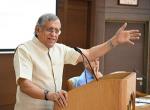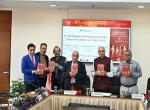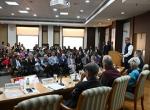The Vivekananda International Foundation organized a discussion with a delegation led by Lt Gen RS Grewal, Director General Medical Services (DGMS), Army, on ‘Remedial Measures to counter possible spread of Coronavirus' on 06 March 2020. Air Commodore VK Sashindran also joined the delegation. The meeting also saw participation of representatives from the Confederation of Indian Industry (CII). The presentations by the DGMS and ensuing discussions highlighted many concerns regarding the coronavirus or COVID-19 epidemic (now declared pandemic by World Health Organization). Some of the salient points raised were:
Overview of Coronavirus
Coronavirus is an RNA virus that has high mutation rates, which can be correlated with enhanced virulence. Three factors used to assess the impact of a virus on a population are- transmission rates, case fatality rates and asymptomatic transmission. For any disease to become an epidemic, the transmission rate has to be more than one. For coronavirus, the range varies from 2.1 to 4.1, almost three times the required number. There is thus a need to decrease transmission by two-thirds to contain the epidemic. That means we have to break the chain in in a large number of population which is a very big challenge. Computing statistics say a person can transmit coronavirus for seven days which will increase infected people by 10 per cent daily. The mortality rate computed by WHO is 3.4 per cent. The asymptomatic transmission is what poses the maximum complexities in dealing with coronavirus.
It is estimated that infected cases will peak in China in early March, and after that it will start rising in other countries outside China. In our own country, the peak will now occur after 3-4 months. While there is lack of clarity on the heat sensitivity of the virus, one could assert that heat may reduce in vitro transmission, with in vivo nature of the virus remaining the same. On initial symptoms, the British Medical Journal noted that common symptoms at the onset of illness were fever (98 per cent), cough (76 per cent), and myalgia or fatigue (44 per cent); less common symptoms were sputum production (28 per cent), headache (8 per cent), haemoptysis or coughing up blood (5 per cent), and diarrhea (3 per cent). Dyspnea or labored breathing developed in 55 per cent of the patients with a median time from illness onset to dyspnea was 8 days. 63 per cent of patients had lymphopenia or limited white blood cells. All patients had pneumonia with abnormal findings on chest CT.
Statistics on fatalities have shown that elderly population and those with compromised immune systems are most vulnerable to the coronavirus. While research is on globally, with universal open access to most journal papers and research studies, there is no lead time to validate and certify vaccine trials to deal with the epidemic. The best precautions thus are to restrict and if possible entirely avoid large public gatherings that will increase transmission rates including pilgrimage sites, malls, theaters, schools, universities, markets, public transportation etc.
Handling the Crisis
The Coronavirus epidemic can only be handled through a synchronous public-private-people partnership. Soap and water were mentioned as the most effective tools to counter coronavirus. The greatest urgency is to take review of all medical equipment, stores and expendables in the country. The Indian pharmaceutical industry has already appraised its requirements to ensure there is no shortage of essential medicines despite disruption in supplies from China. On the question of masks, 3 ply masks and T95 masks were mentioned as the most effective as moisture aggregation in other masks made them ineffective against infection. However, masks were recommended as a tool to be used by the medical and other administrative personnel, and sick people than by the entire populace. On chemicals for sterilization and disinfection, the need to audit stocks of sterillium, formaldehyde, glutaraldehyde, sodium hypochlorite, sterisol and hypochlorous acid and ensure their surplus availability was highlighted. Ventilators and oxygen supplies were also underscored as critical requirements.
Adequate numbers of Personal Protective Equipment is important to reassure medical personnel of their safety. There is need for clearly defined timelines, milestones, and roles and responsibilities to counter the epidemic. Standard Operating Procedures and Best Practices need to be articulated and disseminated to ensure uniformity and resilience of medical infrastructure in the country. The government has already identified 54 labs as testing facilities. They will need to be supported with effective viral media transportation. For quarantine facilities, locations have been earmarked that will need to be maintained by on site boarding, lodging and catering in these facilities. There is also need to draw lessons from prior crises such as the handling of Swine Flu. Panchayats, Anganwadis, religious bodies should aid to ensure there is awareness of the severity of the epidemic at the ground levels. The government should also enforce mandates that prevent hoarding to avoid a public panic.
Recommendations to strengthen Indian Medical Infrastructure
In view of the large population, India needs to prioritize strengthening its infrastructure and institutions to effectively deal with the cascading threat of epidemics and bioterrorism. The model of US Centers for Disease Control and Prevention (CDC) of having field stations could be adopted that constantly monitor the ground situation in India. Further, a Centre for Excellence and Referral Facility needs to be established that can bridge the disciplines of statistics and epidemiology. There is urgency to address the massive Active Pharma Ingredients (API) dependency on China from the highest level of government. Pharmaceuticals is both a major export sector, as well as critical to national security. Government directives also need to be issued that allow for companies to use their funds earmarked for Corporate Social Responsibility to contribute to National Responsibility. The paramilitary forces need to be trained to handle medical threats for the future.







Post new comment